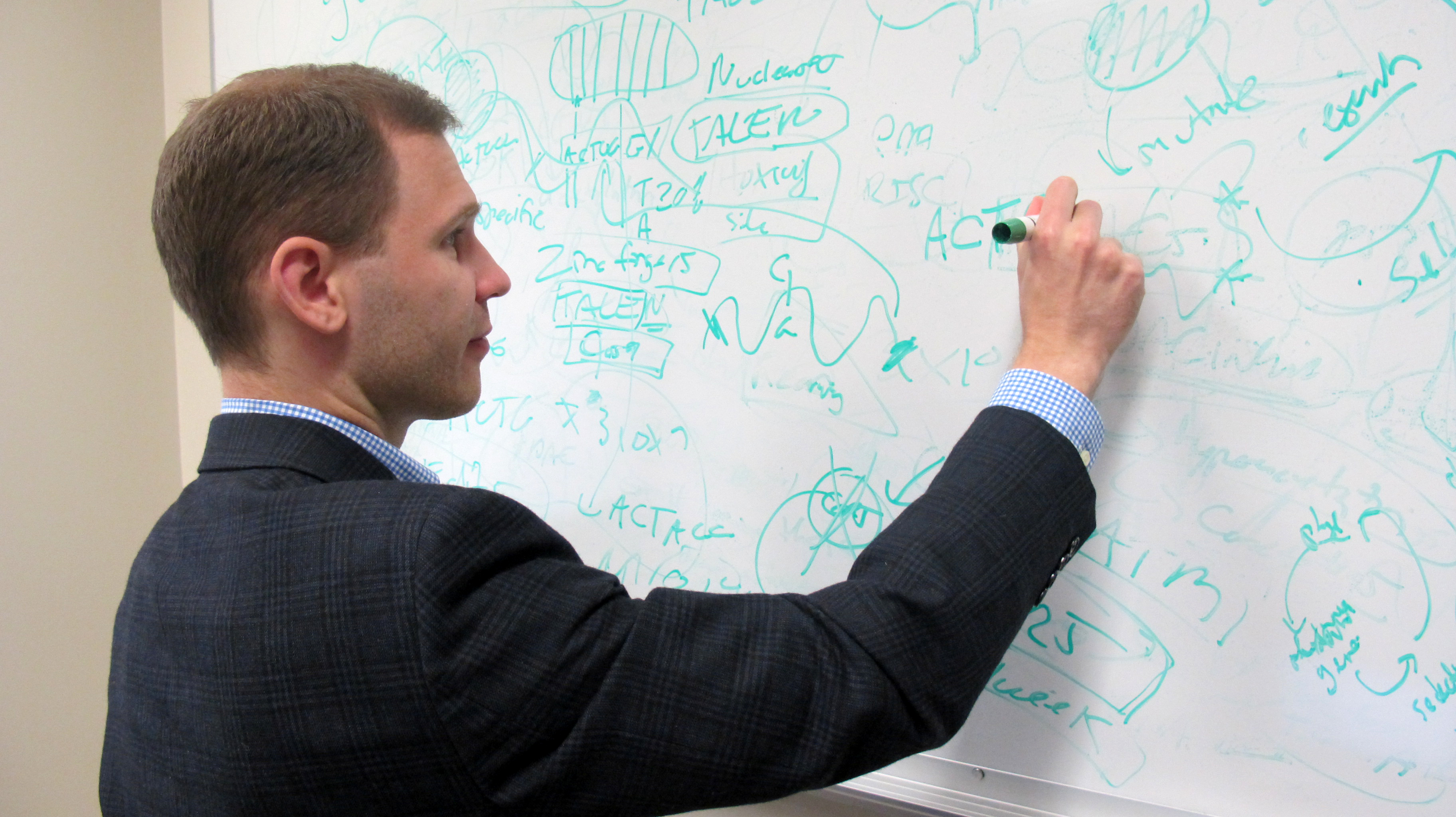
Basil Hubbard is the recipient of a 2016 NSERC Discovery Grant and a Discovery Accelerator Supplement grant.
Funding support from the Natural Sciences and Engineering Research Council of Canada (NSERC) helps UAlberta researchers move their work forward. NSERC's 2016 Research Grant Competition resulted in the Faculty of Medicine & Dentistry receiving 21 grants totaling over $3.4 million in new funding over the next five years. One of the grant recipients is Basil Hubbard, a new investigator who is developing technologies to edit our genes.
Our genetic material determines a lot about us: our height, skin color, certain behaviors and the diseases we are born with, or are predisposed to develop. While our genes have been considered an unchangeable part of who we are, one researcher in the Faculty of Medicine & Dentistry (FoMD) is hoping to change fate for those born with genetic diseases. Funding from NSERC will bolster his research efforts.
Basil Hubbard was recruited to the Department of Pharmacology in January 2015 after completing his postdoctoral work at Harvard University. There, he was introduced to early genome engineering technology including proteins known as zinc finger nucleases (ZFNs), and transcription activator-like effector nucleases (TALENs). ZFNs are currently in clinical trials for the treatment of HIV, hemophilia, and lysosomal storage diseases. Hubbard was quickly drawn to the research area.
"I decided to work on genome editing technologies because I believe that one day they will revolutionize the treatment of countless diseases," says Hubbard. "The idea of permanently curing diseases rather than transiently treating them with drugs is something that appeals to me."
Hubbard's lab received a 2016 NSERC Discovery Grant, as well as a Discovery Accelerator Supplement (DAS) grant, designed to maximize the impact of outstanding research projects. These grants will allow him to fund two new graduate student positions focusing on a relatively new genome editing technology, called Cas9. The total funding is $325,000 over the next five years.
Genome Engineering with Cas9
Cas9 is an enzyme called an endonuclease, which means that it can induce an internal cut in a DNA strand. What's unique about Cas9 is that it can be programmed to target a specific sequence of DNA using a ribonucleic acid (RNA).
"It's sort of like performing molecular surgery." -Basil Hubbard
How does Cas9 find a specific sequence of DNA? It binds to two RNA molecules known as the tracrRNA and the CRISPR RNA (crRNA). Encoded in the user-designed crRNA is the reverse complement of the desired DNA target sequence. Cas9 uses this information in the crRNA to find a matching DNA pair, and then cuts that sequence.
Once a disease-causing gene has been cut, researchers can supply a DNA template strand with the correct sequence, and this becomes permanently incorporated into the genome after DNA repair.
"It's sort of like performing molecular surgery," notes Hubbard.
Challenges with the current technology
One of the main problems with current gene-editing technology is that the process isn't 100 per cent specific. While most of the time Cas9 will cut DNA at the intended location, it will occasionally cut a similar, but undesired sequence.
"Off-target gene cutting is a big concern when considering the therapeutic potential of Cas9," says Hubbard. "Even a single miss-cut could result in serious health problems, such as cancer."
Another issue with Cas9 is that the protein comes from a bacteria. How this protein interacts with other proteins in human cells hasn't been fully examined.
"In addition to off-target gene cutting, there could be problems with acute toxicity." notes Hubbard.
Advancing the technology
With the support of the NSERC grants, Hubbard's lab will develop improved variants of Cas9 that are safer for human use.
To do this, they will use a technique called phage-assisted continuous evolution, or PACE. This evolution platform makes use of both bacteria, and their natural viral predators - bacteriophage. Bacteriophage carrying the Cas9 protein are mutated and allowed to infect a bacterial host cell. Once inside, a reporter gene in the bacteria is used to decide if the mutated Cas9 protein shows improved specificity, or not. Mutated Cas9 proteins that show improved specificity are packaged into new bacteriophages and undergo additional rounds of selection, while those that do not are eliminated from the system. Because this process has been automated using robotic pumps, approximately 60 rounds of evolution can be done in 24 hours, as opposed to traditional techniques which typically carry out only one round per day.
"The whole system runs autonomously with little researcher intervention. This allows us to do evolution at a much faster rate than could normally be done in a lab," says Hubbard.
In addition to improving the specificity of Cas9, Hubbard will also investigate how Cas9 influences the physiology of human cells, and engineer variants with little or no toxicity.
A promising future
"Our goal right now is to help improve the technology to make it safe for human use. Beyond that, we'd eventually like to explore the possibility of using gene editing to produce lasting cures for monogenic diseases - diseases caused by a gene single mutation," says Hubbard.
Monogenic diseases include hemophilia, sickle cell anemia, muscular dystrophy and cystic fibrosis.
"One-day, this technology might also be applied to more complicated diseases caused by multiple mutations, such as cancer."
Our partner in innovation
Natural Sciences and Engineering Research Council of Canada aims to make Canada a country of discoverers and innovators for the benefit of all Canadians. The agency supports university students in their advanced studies, promotes and supports discovery research, and fosters innovation by encouraging Canadian companies to participate and invest in postsecondary research projects.NSERC researchers are at the forefront of science, building on Canada's long tradition of scientific excellence.